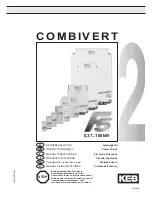
Goodrive300-LIFT series inverter
Communication protocol
-113-
10 Communication protocol
10.1
What this chapter contains
This chapter describes the communication protocol of GD300L series inverters special for lifts.
GD300L series inverters special for lifts support IO expansion cards and provide RS485
communication interface. It adopts international standard ModBus communication protocol to perform
master-slave communication. The user can realize centralized control through PC/PLC, upper control
PC, etc. (set the control command, running frequency of the inverter, modify relevant function codes,
monitor and control the operating state and fault information of the inverter and so on) to adapt
specific application requirements.
10.2
Brief instruction to Modbus protocol
Modbus protocol is a software protocol and common language which is applied in the electrical
controller. With this protocol, the controller can communicate with other devices via network (the
channel of signal transmission or the physical layer, such as RS485). And with this industrial standard,
the controlling devices of different manufacturers can be connected to an industrial network for the
convenient of being monitored.
There are two transmission modes for Modbus protocol: ASCII mode and RTU (Remote Terminal
Units) mode. On one Modbus network, all devices should select same transmission mode and their
basic parameters, such as baud rate, digital bit, check bit, and stopping bit should have no difference.
Modbus network is a controlling network with single-master and multiple slaves, which means that
there is only one device performs as the master and the others are the slaves on one Modbus
network. The master means the device which has active talking right to send message to Modbus
network for the controlling and inquiring to other devices. The slave means the passive device which
sends data message to the Modbus network only after receiving the controlling or inquiring message
(command) form the master (response). After the master sends message, there is a period of time left
for the controlled or inquired slaves to response, which ensure there is only one slave sends message
to the master at a time for the avoidance of singles impact.
Generally, the user can set PC, PLC, IPC and HMI as the masters to realize central control. Setting
certain device as the master is a promise other than setting by a bottom or a switch or the device has
a special message format. For example, when the upper monitor is running, if the operator clicks
sending command bottom, the upper monitor can send command message actively even it cannot
receive the message from other devices. In this case, the upper monitor is the master. And if the
designer makes the inverter send the data only after receiving the command, then the inverter is the
slave.
The master can communicate with any single slave or with all slaves. For the single-visiting command,
the slave should feedback a response message; for the broadcasting message from the master, the
slave does not need to feedback the response message.
















































